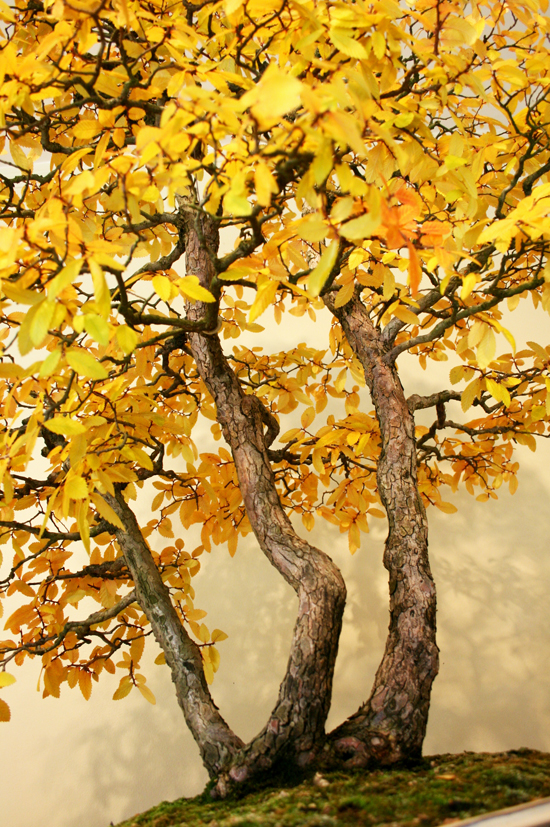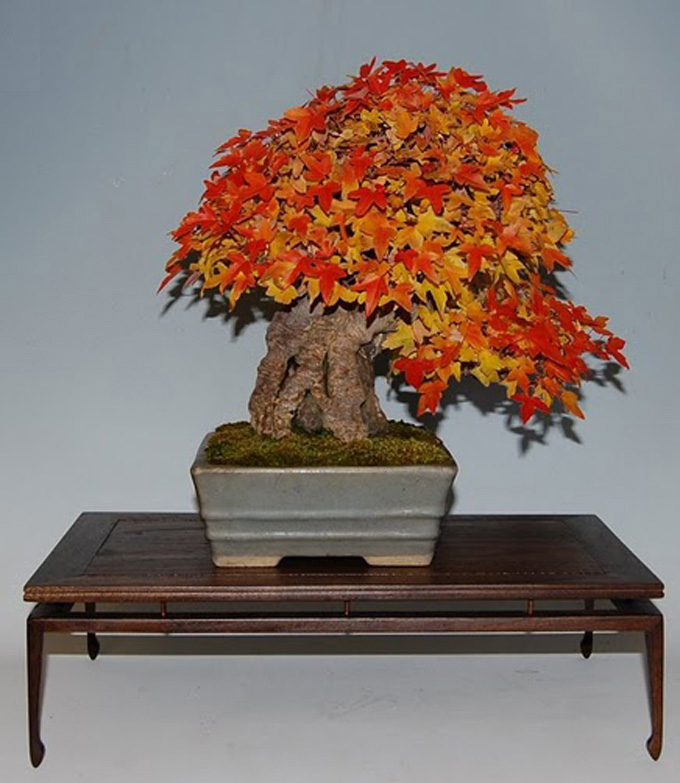 This Japanese Maple was donated to our National Bonsai and Penjing Museum by Ryutaro Azuma. It has been in training since 1906. The photo, like all but one of the photos in this post, is from Capital Bonsai.
This Japanese Maple was donated to our National Bonsai and Penjing Museum by Ryutaro Azuma. It has been in training since 1906. The photo, like all but one of the photos in this post, is from Capital Bonsai.
It has been at least a month since the colors peaked here in northern Vermont, but we can imagine that somewhere, where the climate is a little more relaxed, some lucky people can still look out and see trees all ablaze. Perhaps if you live in the D.C. area, where most of these photos are from (via the Capital Bonsai blog), you are still feasting on fall colors.
If you do live in the D.C. area, maybe you could find your way over to our wonderful Bonsai and Penjing museum and enjoy some of the best bonsai in north America while they have some luminous leaves left to show off. My guess is that it’s just the tail end of the season there and I’ve long thought that the more subtle post-peak pastels provide some of the best leaf peeping of all.
While we’re at it, just in case you’re not familiar with Capital Bonsai, Aarin Packard’s excellent bonsai blog that features bonsai and bonsai events at our National Arboretum (other bonsai stuff too), this is a good time to check it out.
 There are at least two things to love about Liquidambar. First, is the brillance of their fall colors (Aarin of Capital Bonsai writes “the photo doesn’t do the tree justice regarding its actual color. Its almost a neon red. When you see it in person the tree seems like it is glowing”). Second is… you don’t have to live in a cold climate to enjoy this brilliance. In some southern and far western climes (like Northern California) liquidambars provide by far the most brilliant fall color (in some places they are the only tree with real fall color). BTW, this luminous little tree was donated to the National Museum by Vaughn Banting.
There are at least two things to love about Liquidambar. First, is the brillance of their fall colors (Aarin of Capital Bonsai writes “the photo doesn’t do the tree justice regarding its actual color. Its almost a neon red. When you see it in person the tree seems like it is glowing”). Second is… you don’t have to live in a cold climate to enjoy this brilliance. In some southern and far western climes (like Northern California) liquidambars provide by far the most brilliant fall color (in some places they are the only tree with real fall color). BTW, this luminous little tree was donated to the National Museum by Vaughn Banting.
 A truly distinctive tree showing off its fall colors and much more. Here’s Capital Bonsai’s caption… “Trident Maple, Donated by Stanley Chin, Age Unknown.”
A truly distinctive tree showing off its fall colors and much more. Here’s Capital Bonsai’s caption… “Trident Maple, Donated by Stanley Chin, Age Unknown.”
 I like this Cedar Elm (Ulmus crassifolia) close up. Feels like you’re standing under a full-sized tree. It was donated to the Museum by Arch Hawkins and has been in training since 1981.
I like this Cedar Elm (Ulmus crassifolia) close up. Feels like you’re standing under a full-sized tree. It was donated to the Museum by Arch Hawkins and has been in training since 1981.
 This one is not from Capital Bonsai but I couldn’t resist. It’s a root-over-rock (root-swallowed-rock) Trident maple from Kaede Bonsai-en that we featured here on Bark almost a year ago.
This one is not from Capital Bonsai but I couldn’t resist. It’s a root-over-rock (root-swallowed-rock) Trident maple from Kaede Bonsai-en that we featured here on Bark almost a year ago.
One of the best trees for color in S. FL is crepe myrtle.
Once, when John Naka was in town, he wanted to buy 75 liquidambar seedlings to do a fist planting for his 75th birthday. I told him no nurseries sold them, because it was considered a weed tree. Then I showed him a group of thousands of seedlings on the edge of a parking lot, and easy to collect. He did, instead, a 200 tree planting for the bicentennial.
In the talk of liquidambar, you missed the fragrance of the resin, which is called storax (thus, L. styraciflua), and was once a perfume ingredient.
Hi Terry,
Great Naka story.
Didn’t know about the fragrance.
Thanks